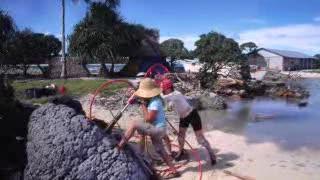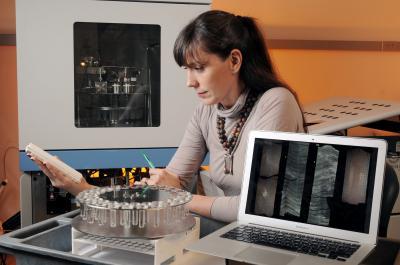The researchers collected the coral samples by drilling into massive coral "rocks" rolled onto Pacific island beaches by the action of strong storms or tsunamis. Cobb and her team studied 17 such cores of varying lengths and ages recovered from beaches on Christmas and Fanning Islands, which are part of the Line Island chain located in the mid-Pacific.
The islands are ideal places for obtaining records of past ENSO activity because they are close enough to the source region for ENSO to be affected by its temperature and precipitation variations, but not so close that the islands' corals are bleached by large temperature increases during strong El Nino warm events.
The study of each core began with careful dating, done by analyzing the ratio of uranium to thorium. That work was performed by co-authors Larry Edwards and Hai Cheng at the University of Minnesota. Once the age of each core was determined, Cobb and her team chose a subset of the collection to be studied in detail.
They sawed each core in half, then X-rayed the cross-sections to reveal the growth direction of each coral. The researchers then drilled out small samples of coral powder every millimeter down the core and analyzed them with mass spectrometers at Georgia Tech and the Scripps Institution of Oceanography to determine the ratio of oxygen isotopes.
The isotope ratio of the coral skeleton changes with the temperature and amount of rainfall, providing detailed information about environmental conditions during each period of the coral's growth. As many as 20 samples are analyzed for each year of the coral's lifetime.
"We are able to count back in time, following the seasonal cycles locked in the coral skeleton, as long as the core will allow us," Cobb explained.

By studying a set of fossil corals that are as much as 7,000 years old, scientists have dramatically expanded the amount of information available on the El Nino-Southern Oscillation, a Pacific Ocean climate cycle that affects climate worldwide. This video explains how the research was done.
(Photo Credit: Inertia Films/Georgia Tech)
In all, Cobb's team added 650 years of monthly-resolved information about ENSO variations across nearly 7,000 years. That required analyzing approximately 15,000 samples over the course of the study, which began in 2005.
Using the new sequences to quantify the range of natural variability in ENSO strength, the researchers have detected a modest, but statistically-significant increase in 20th century ENSO strength that may be related to anthropogenic climate change. However, the coral reconstruction shows an even higher level of ENSO strength 400 years ago, though its duration was shorter.
"The level of ENSO variability we see in the 20th century is not unprecedented," Cobb said. "But the 20th century does stand out, statistically, as being higher than the fossil coral baseline."
Information about the El Nino-Southern Oscillation is important for climate scientists because the cycle helps drive other aspects of global climate change.
"El Nino is something that people want to know about when they reconstruct past climate changes at a specific site," Cobb said. "Our data will provide a reference for the magnitude of ENSO-related changes that may have occurred, and allow researchers to probe the causes of past climate changes evident in other paleoclimate records and in model simulations of past climates."
The work has already called into question a long-held belief that ENSO was reduced some 6,000 years ago. Certain climate models support that picture, but Cobb said that fossil coral data from that period doesn't support a reduction in ENSO strength.
Looking to future research, Cobb believes the work will be useful in helping scientists assess the accuracy of climate models.
"Prior to this publication, we had a smattering of coral records from this period of interest," she said. "We now have tripled the amount of fossil coral data available to investigate these important questions. We have been able to provide a comprehensive view of recent variations in ENSO."

Fossil coral cores taken from the Line Islands provide information about the strength of the El Nino Southern Oscillation (ENSO) for periods of time as much as 7,000 years ago. The paper rules track the direction of coral growth.
(Photo Credit: Georgia Tech Photo: Gary Meek)

Georgia Tech associate professor Kim Cobb holds slabs of fossil coral taken from cores drilled in the Line Islands in the mid-Pacific Ocean. Powder from the slabs is examined in the mass spectrometer, which measures the ratio of oxygen isotopes to assess the strength of ENSO during the time the corals were growing.
(Photo Credit: Georgia Tech Photo: Gary Meek)